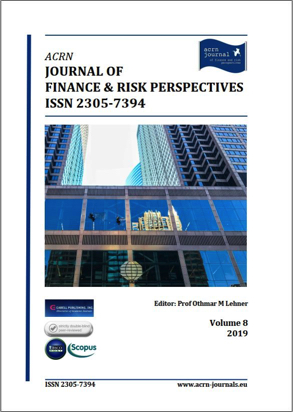Mohamed Sadok Gassouma, 2019, Abnormal accounting accrual Management by internal and external Market Discipline: The case of Tunisian banks in the context of the ‘Arab Spring’, ACRN Journal of Finance and Risk Perspectives, 8 (1), 106-122

Mohamed Sadok Gassouma
Institute of Finance and Taxation of Sousse, Tunisia
Abstract
Problem/Relevance: This paper deals with such market disciplinary factors as shareholder ownership, audit committee composition and Basel III prudential regulation affecting accounting manipulation measured by abnormal accruals in Tunisian banks in the event of managerial deviation from regulatory requirements
Research Objective/Questions : The aim of this study is to estimate the abnormal accruals that measure the accounting manipulation, and to test the effect of disciplinary and regulatory factors accordingly to The spring Arab revolution, on accounting Manipulation.
Methodology: We propose to construct abnormal accruals as an endogenous variable, using the classic Kothari model (2005), in order to explain them by means of the “difference-in-difference” estimation approach (DID), understand the significance of the evolution of the manipulation, and explain these accruals using internal and external disciplinary factors. On the other hand, we use the credit risk portfolio manipulation theory advocated by Nessim (2003) and Repullo (2007), to understand the concept of actual venture capital of Tunisian banks after the Arab Revolution.
Major Findings : The results show that the situation of Tunisian banks has dramatically worsened since the Tunisian Revolution. The DID approach showed an exacerbation of abnormal accruals and a manipulation transfer from net income smoothing to credit portfolio value smoothing in order to reach a healthy financial situation. This aggravation is linked to the market discipline deterioration, the shareholders, the external auditors and the supervisory board.
Implications : Before the Revolution, accounting manipulation was mainly caused by banking undercapitalization that led managers to offer more risky credit in a diluted ownership market and in an informational asymmetry situation characterized by the absence of the audit committee. After the Revolution, accounting manipulation resulted from an overcapitalization situation, which led managers to grant more risky credit. To circumvent the shareholders’ supervisory power, managers manipulated credit portfolio values, offering a low level of credit risk, and circulating false beliefs for shareholders and depositors. This was done when prudential supervision was weak, leading to an information asymmetry and long-term conflict of interest between external auditors and managers through abnormal remuneration and a long relationship.
Back to Volume 8